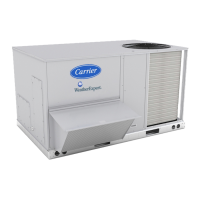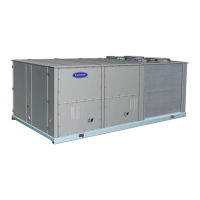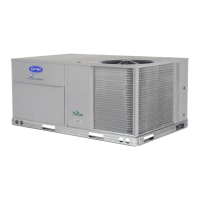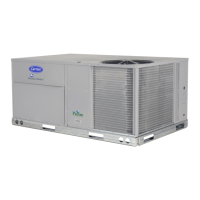127
T701 (Staged Gas 1 Thermistor Failure)
T702 (Staged Gas 2 Thermistor Failure)
T703 (Staged Gas 3 Thermistor Failure) — If any of the
staged gas thermistors (Tempe ratures
AIR.T
S.G.L1-3)
fails, an alert will be generated and the remaining thermistors
will be averaged together (Temp erat ures
AIR.T
S.G.LS)
without the failed thermistor. Recovery is automatic. Reason
for failure may be incorrect wiring, faulty thermistor, or a dam-
aged input on the staged gas control board (SCB).
A704 (Staged Heat Lvg Air Temp Sum Total Failure)
— If
all three staged heat thermistors (Temperatures
AIR.T
S.G.L1,2,3) fail, staged heat will be shut down and this alarm
will be generated. Recovery is automatic. Reason for failure
may be faulty wiring, faulty thermistors, or damaged inputs on
the staged gas control board (SCB).
T705 (Limit Switch Thermistor Failure)
— A failure of this
thermistor (Temperatures
AIR.T
S.G.LM) will cause an
alert to occur and a disabling of the limit switch monitoring
function for the staged gas control board (SCB). Recovery is
automatic. Reason for failure may be due to faulty wiring, a
faulty thermistor, or a damaged input on the staged gas control
board (SCB).
A706 (Hydronic Evap Discharge Thermistor Failure)
— If
the unit is configured for hot water heating (hydronic), then the
unit has a thermistor (Temperatures
AIR.T
CCT) installed
between the evaporator coil and the hot water coils that func-
tions as the evaporator discharge temperature thermistor for
cooling. If this thermistor fails, an alarm will be generated and
the system will be shut down. Recovery is automatic. Reason
for failure may be due to faulty wiring, a faulty thermistor, or a
damaged input on the EXB control board.
T707 (Digital Scroll Discharge Thermistor Failure)
— If the
RXB control board is not receiving a signal from the discharge
temperature thermistor, the alarm is generated. The thermistor
may be missing, disconnected, or a wire may be broken.
The alert will be generated and the digital scroll capacity
will be locked at 50%. Reset is automatic.
MAJOR SYSTEM COMPONENTS
General —
The 48/50N Series package rooftop units with
electric cooling and with gas heating (48N units) or electric
cooling and electric or hydronic heating (50N units) contain the
ComfortLink electronic control system that monitors all opera-
tions of the rooftop. The control system is composed of several
components as listed below. See Fig. 23-31 for typical control
and power component schematics. Figures 32 and 33 show the
layout of the power and control box.
Factory-Installed Components
MAIN BASE BOARD (MBB) — See Fig 34. The MBB is
the center of the ComfortLink control system. The MBB con-
tains the major portion of the operating software and controls
the operation of the unit. The MBB has 22 inputs and 11 out-
puts. See Table 93 for the inputs and output assignments. The
MBB also continuously monitors additional data from the
EXB, EXV, RXB, SCB, and CEM boards as well as the VFDs
through the LEN communications port. The MBB also inter-
faces with the Carrier Comfort Network
®
system through the
CCN communications port located on the COMM3 board. The
COMM3 board has permanent terminals as well as a J11 jack
for temporary connections. The board is located in the control
box.
ROOFTOP CONTROL BOARD (RXB) — The RXB com-
municates with and controls the damper actuators, hydronic,
and humidifier valves. The RXB has additional inputs and out-
puts required for the control of the unit. All units have an RXB
board. See Fig. 35. The board has 9 inputs and 8 outputs. De-
tails can be found in Table 94. The RXB board is located in the
control box.
ECONOMIZER CONTROL BOARD (EXB) — The EXB
is used on units with options including return fan, digital scroll
compressor, VFD with bypass, low ambient or accessory hu-
midifier. See Fig. 35. The board has inputs to sense the return
fan cfm and supply fan cfm. This board is located in the control
box. Input and output assignments are summarized in Table 95.
STAGED GAS HEAT BOARD (SCB) — When optional
modulating gas heat is used, the SCB board is installed and
controls additional stages of gas heat. See Fig. 36. The SCB
also provides additional sensors for monitoring of the supply-
air and limit switch temperatures. For units equipped with
modulating gas heat, the SCB provides the 4 to 20 mA signal to
the SC30 board that sets the modulating gas section capacity.
The SCB is also used for the optional SCR electric heat, prog-
nostics or heat reclaim. This board is located in the control
box. The inputs and outputs are summarized in Table 96.
CONTROL EXPANSION MODULE (CEM) — The optional
CEM is used to provide inputs for demand limiting, remote set
point and other optional inputs typically needed for energy
management systems. See Fig. 37. On CCN systems these in-
puts can be interfaced to through the CCN communications. It
is located in the main control box. The CEM also has inputs for
accessory relative humidity sensors. This board is also used on
units equipped with optional outdoor air CFM monitoring. The
inputs and outputs are summarized in Table 97.
The optional (or accessory) CEM is used to accept inputs
for additional sensors or control sequence switches, including:
• Smoke control mode field switches
• VAV supply air set point reset using an external 4 to
20 mA signal
• Outdoor air CO
2
sensor
• Space, return and/or outdoor air relative humidity
sensors
• IAQ function discrete switch
• Air filter monitoring switches and transducers
• Demand limit sequence proportional signals or discrete
switches
The CEM is factory-installed when the outdoor air cfm con-
trol option is installed.

